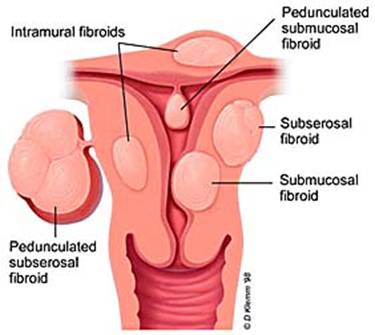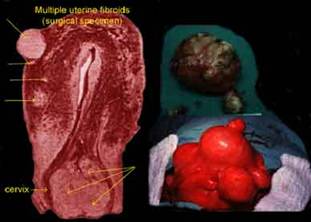 What is a Uterine Fibroid?
What is a Uterine Fibroid?
- Benign tumor of uterine smooth muscle
- Fibroids are not pre-cancerous
- Also referred to as myomas or leiomyomas
How Common are Uterine Fibroids?
- Estimated that 25 to 50% of women eventually develop fibroids
- Fibroids most frequent ages 30s and 40s
- Most common tumor of the pelvis in females
- 10% to 30% of women with fibroids are symptomatic
What Causes Fibroids?
- Exact cause currently unknown
- Fibroid development and growth is linked to estrogen and progesterone
- Evidence that progesterone may stimulate fibroid growth
- Genetic predisposition is probable
What Symptoms Occur with Uterine Fibroids?
- Heavy menstrual bleeding, sometimes with passage of blood clots. Anemia can occur if bleeding is severe
- Pain, pressure or feeling of fullness in the pelvis, abdomen or lower back
- Frequent urination or constipation
- Pain during or bleeding after intercourse
- Infertility or miscarriage
- Distended abdomen
 How are Fibroids Diagnosed?
How are Fibroids Diagnosed?
- Clinical history and physical exam
- Pelvic ultrasound
- Magnetic Resonance Imaging (MRI)
- Laparoscopy or hysteroscopy
How did Uterine Fibroid Embolization (UFE ) Evolve?
- Embolization of uterine arteries for severe post-partum or post-traumatic hemorrhage performed for over 20 years
- Jacques Ravina, French Gynecologist, in 1990 performed UFE two weeks prior to myomectomy in order to decrease blood loss
- Women cancelled myomectomy procedure because they noticed bleeding, pain and bulk symptoms improved after Uterine Fibroid Embolization
- This discovery has lead to a promising new alternative treatment-UTERINE FIBROID EMBOLIZATION!
